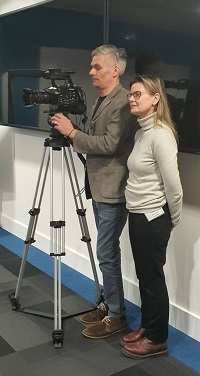On-camera confidence can be difficult to acquire. This isn’t because the camera or the TV journalist is out to get you; this is often far from the case. The camera professional will want to make their work look excellent and they’re not going to do that by making you look foolish.
Indeed, part of the trick is to make you look even better than you are. Some people still find it intimidating, though and this is a pity. So many media outlets now incorporate video into their offerings that if you’re a spokesperson, whether a chief executive or a manager, someone is going to ask you to go on screen very soon.
Here are some ideas to help you overcome your fears.
On-camera confidence on Zoom
If you’re hosting a video conference you need to look attentive. This can mean doing the counter-intuitive thing of not looking at the faces of the people on the screen but at the camera. It will then look to the listeners as if you’re looking them in the eye. You can buy a camera that sticks to the screen so the eye line is right – our lead trainer Guy has one – but make sure it’s stuck on properly before you start. If it falls off half way through then you will look as if you’re in the middle of an earthquake!
Think also about livening up any Powerpoint or similar presentations without going berserk. Making individual bullet points on a slide appear individually rather than all at once can be a subtle way of making it more engaging. You might consider putting animations in. Bear in mind that people on slower connections might see them looking very jerky. Also if you’re going to use stock images make sure they’re good ones. The same old image of people shaking hands is dull, dull, dull!
On-camera confidence in a studio
Our main camera operator Paul offers a couple of good tips in our promotional video:
If you don’t have time to watch it, the first thing he says is that if you talk with your hands then tell the camera operator – you’ll look better if they line up a shot with your hands in it properly rather than a tighter shot in which the focus is on your face alone with the odd thumb wafting into view.
We offer media training sessions both with and without a professional camera rig. Each of our camera experts offers so much more than pressing the buttons and operating the equipment; there is no substitute, if you’re likely to go out on video, for sitting under proper lighting in front of a professional-standard rig with an award-winning documentary maker like Paul offering counsel.
More basics
There are other basics to learn as well:
-

Paul Angell and Sophie Aldred at a Clapperton Media Training session Look at the interviewer rather than the camera. It always looks more sincere and you’ll find it easier to talk to a single person rather than thinking there are thousands watching on the other side of the lens. If the interviewer is elsewhere and you’re doing “down the line” then you look at the camera.
- Do as the camera operator suggests – they know what they’re doing. If they make you uncomfortable, though, maybe getting you to perch on a desk when you’d be happier standing or on a proper chair, say so. It’s your interview.
- That said, if you’re in a studio and someone advances upon you with make-up, let them do their job.
- If you’re going to be seated, avoid swivel chairs – you’ll spend too much time concentrating on not swiveling.
- Also on chairs: if you can avoid chairs with arms, so much the better, you don’t want to look hunched on the TV.
- Remember people’s attention more or less falls off a cliff when you’re on video. If you can get your points in quickly, even if you have to say “I’ll get to that question in a second” and get them in first (but do come back to the question), you’ll be sure to get your points in.
- Remember that a good soundbite will be played over and over again. So will a bad one!
That last point is a good cue to remind yourself that the basics count for a lot whichever medium your interview is for:
- Prepare – you’re allowed to forget a figure or not have a fact to hand but make sure you know your stuff.
- Try not to be too salesy. If the audience feels you’re just after their money they won’t like it.
- If a journalist is unusually aggressive or insistent when you can’t answer a question, be polite. The viewers will see you’re being reasonable.
- Be succinct and keep it as simple as you can. The more brief and memorable your point, the less likely it is to become confused later on.
Finally remember one thing. In spite of all of the horror stories you hear, journalists are unlikely to be out to get you. Unless there’s something seriously wrong (and crisis management is something else), the audience will listen with interest
Do you or your clients need help with your media interactions? Our team is here to help. Contact Lindsay or Guy to arrange an initial chat.



